The Bottle Itself:
Bottles embossed with or having labels marked “Made in Occupied Japan” were made from September 1945 until April 1952.
Enameled lettering, also known as serigraphy (instead of labels), on glass bottles started being used after the 1930’s and was pretty regular feature in the 1940’s onward. This lettering is fragile and can be easily lost with cleaning.
Look for a patent number on the base of the bottle, these patent dates were frequent in the 1930’s and 1940’s, you can look up the number on search engines on US patent webpages online. Also, English Registry Design numbers can also be found on perfume bottles from the United Kingdom, you can search the numbers online also.
Old glass bottles might have etched matching numbers on the base of the perfume bottle and on the bottom of the stopper. This was done at the factory when the stopper would have been ground to fit the bottle, the numbers are to show which bottle goes with the right stopper. These were usually found on French bottles such as Baccarat.
Older bottles stamped their name and origin somewhere on the bottle. In the 1940’s, stickers replaced the stamping but were soon lost or destroyed, making it difficult to authenticate.
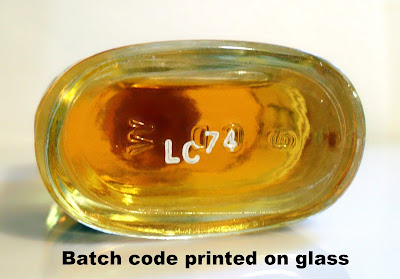
Older bottles from the 1930’s-40’s would have lot numbers, bottle shape numbers or patent numbers embossed right into the glass base.
By 1970, cosmetic companies were stamping colored numbers on the bottom of their products. This stamping usually consisted of four numbers and was visible on the bottom of each item and is a “batch code”, which is used by the company to note what year and month the product was created. Batch codes are often found either stamped on the glass or the label.
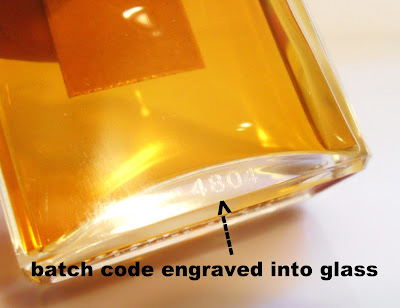
Later, many bottles often have their batch codes engraved into the glass; (Chanel, Dior, Thierry Mugler, etc).
Labels:
Old labels turn brown naturally, however, water and perfume can cause stains on labels over the years.
The styles of the boxes or labels can also help determine age. Art Nouveau is generally 1900-1920’s, Art Deco mid 1920’s and some styles carried into the 1940’s, psychedelic late 1960’s-early 1970’s. Please note that this isn’t always foolproof.
At the beginning of the 20th century, revenue stamps appeared on the imported scents coming into America. This stamped container is very collectible, because of the information on that stamp.
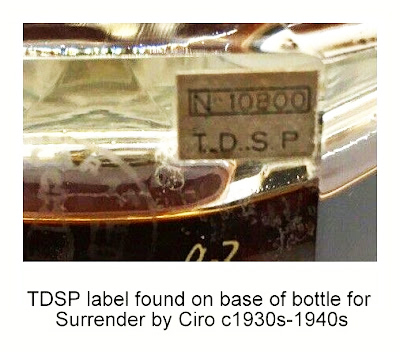
On bottles destined for the Mexican market, you may find labels with a number and the initials TDSP, this stands for Tratado sobre el Derecho Sustantivo de Patentes (Substantive Patent Law Treaty). I have found these small labels on bottles from the 1930’s and 1940’s. The companies found were both Chanel and Ciro. I am sure there are plenty others. I am unsure if this is a patent or trademark used on the perfume name itself or the bottle design, I suspect it was for the perfume name, such as Chanel No. 5. or Surrender by Ciro. These names were registered in Mexico to protect the brands.
Always look at all sides of a bottle. Some labels can be read from both sides, looking thru the back of the bottle. You might encounter labels which have the date stamped on the back of the labels. Sample bottles from the 1950’s onward, often had labels that would say “sample, not to be sold”. Today’s bottles read “tester”. Factice, or display bottles, were not meant for resale, and will have labels such as: “dummy, not for sale”. Sometimes a date is also stamped on the backside of the label, I have seen this with old Chanel and Lanvin bottles. Chanel bottles from the 1960’s onward should have the backs of their labels marked with a copyright symbol and CC.
If your bottle has a label which states: “returning this bottle to the perfumer is a national duty” … then your bottle dates from 1940-1945 during World War II.
If your label states that the perfume was “created/compounded/assembled” in France or USA, it dates to after the 1940’s and most likely dates to the 1950’s.
Perfume bottles with labels using the word “drams” can be dated to before 1950. A dram is 1/8 fluid oz.
The presence of clear labels indicating contents were first used around the 1950’s. These are either on the front, back or base of your bottle.
If your bottle has a label stating SDA (Specially Denatured Alcohol) it dates to the 1940’s-1950’s.
If your box or label has a number with a degree symbol, this notes the perfume or cologne’s alcohol percentage. Two common percentages are 80% and 90% for eau de toilette and cologne. This helps date the bottle to after the 1950’s.
A Zip Code on a label denotes age meaning this bottle is from 1962 or later. Before 1937, no zip codes were used. From 1937 to 1962, two code numbers were used on mail and labels. In 1962, all zip codes were required by the US Postal Service.
By Manufacturer:
Look on the base of your bottle for acid stamps for Baccarat, Lalique, Cristal Nancy or Cristal Romesnil, these markings add value to your bottle. Cristal Nancy closed their doors in 1934. Only from 1936, Baccarat bottles were systematically engraved with a mark. Prior to this, they were acid etched, stamped and some had round paper labels, while many have no distinguishing marks.
Lalique perfumes were marked with a signature on the bases. The signature has changed over the years and you can date a bottle by the style of the signature. Older bottles are marked R. Lalique in block lettering. You can look up various websites or books on Lalique to find signatures and the dates they were used. If your bottle is signed Rene Lalique or R. Lalique, this mark was used until 1945 when Rene Lalique died, after this date bottles will be simply marked Lalique France.
If your bottle has an embossed entwined HP mark on the base of the bottle, it was made by the glass factory of Pochet et du Courval in France after 1930.
If your bottle is marked S or SGD on the base, it was manufactured by the Saint Gobain Desjonqueres glass factory of France after the 1950’s, when the factory was rebuilt after WWII and equipped with modern fully-automatic machinery.
Brosse of France after the 1920’s when the factory installed semi-automatic bottle making machines. In 1963, Brosse switched from making hand ground stoppers to precision machine grinding. In 1976, Brosse patented two new stopper innovations, the first is a ring made of polypropylene with horizontal joints placed on the stopper dowel. The second is a polypropylene coating of the stopper dowel designed with internal friction teeth.
If your bottle is marked Gaillard, J. Viard or J. Villard, it was made during 1900-1920’s. Lucien Gaillard was a contemporary of Lalique and designed many Art Nouveau perfume bottles for notable French perfume houses such as Clamy and Violet. Julien Viard was a French glass designer of the 1920’s and designed bottles for Richard Hudnut, Isabey, Favolys and Langlois. Both Gaillard and Viard collaborated and you might find the mark of J. Villard on some bottles.
Caps or Stoppers:
Older perfumes are sealed with onion skin, viscose or thin celluloid in either red, clear, blue or other colors.
Bakelite screw caps were in usage from 1930’s-1950’s. Some perfume bottles, as the ones for Lanvin, often continued using black Bakelite screw caps into the 1960’s. If you rub the cap with your finger briskly or hold it under hot running water (remove cap from bottle first!) for about 20-30 seconds, then smell it, if it has a formaldehyde odor, it is Bakelite.
Lucite caps were used from the late 1930’s-onward. The older lucite caps become yellowed or discolored from perfume and can have small fractures or chips.
Another feature was the use of plastic caps placed over the base of a ground glass stopper. The finest plastic caps began to be used by 1970 when the glass factory of Saint Gobain Desjonqueres introduced the first plastic covered dowel stoppers.
Glass stoppers that had dowels that went into corks were in use from 1870’s-1920’s.
Goldtone plastic screw caps were in use after the 1940’s.
Goldtone metal screw caps were in use from 1920’s onward.
Boxes & Packaging:
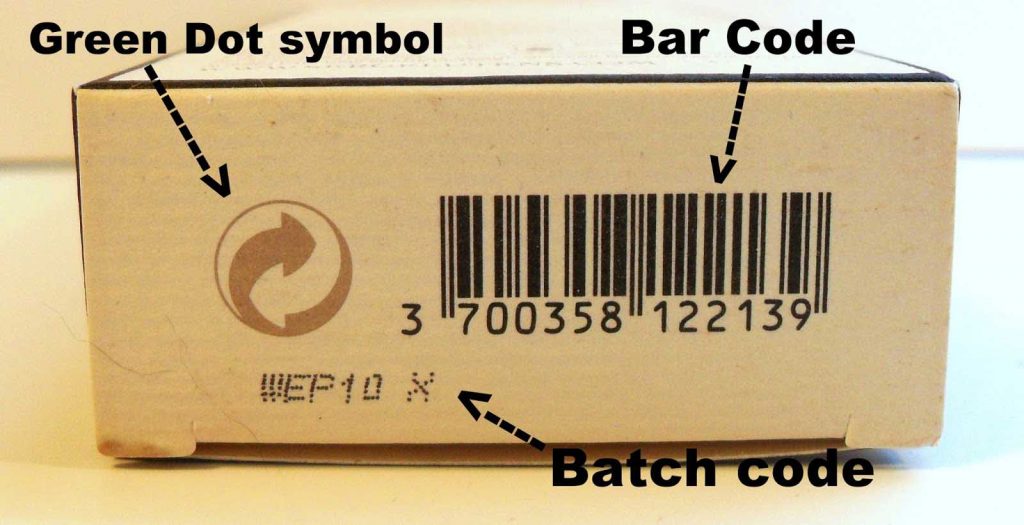
If there is a EAN barcode on the box, this perfume dates to after 1989.
Starting in 1992, the Green Dot recycling symbol will appear on the box.
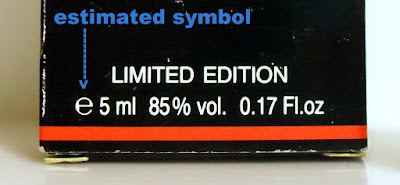
If there is an e-sign, also known as the estimated sign, next to the volume, it was made after 1976. This is a mark that can be found on some pre-packed goods in Europe and indicates that the packaging is filled according to the European Union Directive.
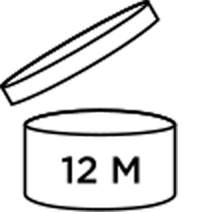
Period-after-opening symbol or PAO, is a graphic symbol that identifies the useful lifetime of a cosmetic product after its package has been opened for the first time. It depicts an open cosmetics pot and is used together with a written number of months or years. This symbol has been in use since 2005.

Refer to Insert: A hand pointing at a book means there is information or instructions contained on a leaflet, booklet, or other insert which can’t be listed on the primary label. The information can be things like an ingredients list, usage instructions, or warnings. This symbol is particularly useful for smaller cosmetic products since they don’t have enough space on their container to list all the product’s information. This has been in use at least since 2005.
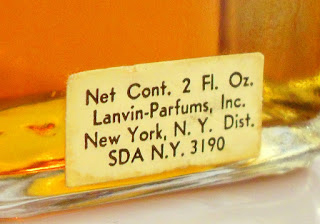
The Fair Packaging and Labeling Act is a U.S. law that applies to labels on many consumer products. It requires the label to state:
* The identity of the product;
* The name and place of business of the manufacturer, packer, or distributor; and
* The net quantity of contents. The contents statement must include both metric and U.S. customary units.
Passed under Lyndon B. Johnson in 1966, the law first took effect on July 1, 1967. The metric labeling requirement was added in 1992 and took effect on February 14, 1994.
From 1998-2003, a short list of ingredients are listed on the back of the box. Prior to this a box may only have listed the following ingredients: water, alcohol, fragrance. Older bottles, will have no ingredients listed at all.
By 2004, there will be a long, complicated list of ingredients listed on the back of the box.
Cellophane packaging was developed in 1908 by a Swiss textile engineer, Jacques Brandenberger, and in 1917 assigned his patents to La Cellophane Societe Anonyme and joined that organization. On December 26, 1923, an agreement was executed between Du Pont Cellophane Company and La Cellophane by which La Cellophane licensed Du Pont Cellophane Company exclusively under its United States cellophane patents. It was originally used to wrap luxury items, but was expensive and not moisture proof. Finding early perfumes with cellophane packaging is very rare. It wasn’t until the late 1930s that cellophane started to become a regular feature on perfume box packaging.
If your label or box has the perfume company’s address, you might be able to date the bottle by comparing the addresses for the company if a company has had more than one address.
The styles of the boxes or labels can also help determine age. Art Nouveau is generally 1900-1920’s, Art Deco mid 1920’s and some styles carried into the 1940’s, psychedelic late 1960’s-early 1970’s. Please note that this isn’t always foolproof.
Some perfume boxes or labels might have a warning label such as: “Warning–Use only as directed. Intentional misuse by deliberately concentrating and inhaling the contents can be harmful or fatal”. This warning was approved by the FDA starting in 1975.
Any cosmetic, perfume or lotion labeled “hypoallergenic” dates to after 1975, when the FDA allowed companies to mark their products in this manner.
Miscellaneous:
The word “dram” to denote contents was used mostly during the 1930’s and 1940’s. It is equal to about 5 ml or 1/8 oz. Dram bottles were small, usually purse sized, but were an economic and affordable way for women to purchase their favorite perfumes during the Great Depression and the WWII period.
Sealed perfumes which look to have some perfume missing, have had their alcohol and water content evaporated, this is caused by heat, light, and poor storage as well as aging.
Vintage perfume will start to darken and the oldest perfumes have a very dark, thick, syrupy texture due to the alcohol and water evaporating, which leaves only a high concentration of essential oils and aroma chemicals behind. If you still wish to wear the perfume, it can be revived with some perfumer’s alcohol or worn as parfum, though it will never smell fresh like it once was.
Check out vintage advertisements for perfumes in old magazines. They will usually have a date on them and you can use these to compare your bottle to what is shown in the ad.
DATING REALLY OLD FRAGRANCE BOTTLES by Bill Ellis
(usually without labels)
These are some characteristics of very old bottles, that may help you in dating them, based on my experience with old bottles and drawing on information in Glass – Volume 2, by Jane Shadel Spillman (1983) – one of the Knopf Collectors’ Guides to American Antiques.
Rough pontil – before 1850 (“bottles made later only occasionally have rough pontils”) [Spillman, p. 16] A “rough pontil” mark is a circular broken glass edge centered on the bottom of the bottle, where the pontil rod was broken from the bottom after blowing the bottle.
Flanged lip – first half of 1800s in the US [Spillman, bottle #65] A wide thin lip on a bottle formed by spreading the mouth of the bottle
Free blown or part-size molds – 1800-1830 in the US; no uniformity in size or pattern; not attributable to the glass house unless the bottle has an identifying mark [Spillman, pp. 12, 34] Free-blown bottles have no mold seams;bottles made in part-size molds may have a mold seam around the bottle at the shoulder; the upper part of the bottle was finished by hand.
Full-size molds – starting 1820, all bottles by 1830 – uniform size and pattern [Spillman, p. 34] Bottles made in full-size molds have vertical seam lines from the base to the neck; the upper neck and lip were finished by hand.
Automatic bottle-blowing machines – starting in the late 1800s [Spillman, p. 35] Machine-made bottles have a mold seam from the base through the lip; the whole bottle is molded at one time.
Source: “How to Date Your Perfume Bottle” article on Cleopatra’s Boudoir website.
Editor’s Note: Also check the “Ephemera: Commercial Perfume Print Ads” in our Virtual Museum. We have over 1,200 print ads for Commercial perfumes. Upon occasion, we have ads documenting that a fragrance was available earlier than indicated in other reference materials.